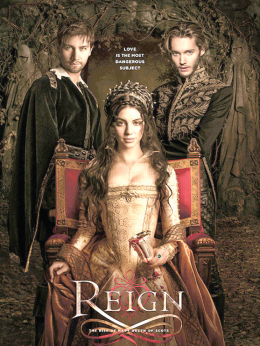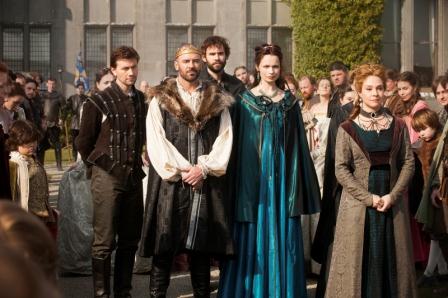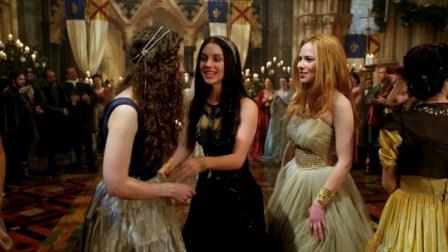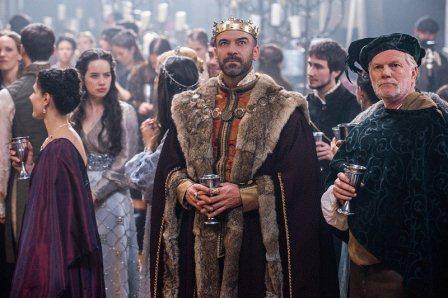Charlotte C. Wells
University of Northern Iowa
A wise older friend occasionally tries to convince me that historical fiction can convey the emotional resonances of the past more effectively than mere fact-based analysis and thereby enhance our understanding. My mentor agrees that we all recreate the past in our own image but argues that fiction shaped by learning can suggest how other times felt to those for whom they were the present. I had some faint hope of such trans-temporal sympathy when I sat down to watch the CW Network’s series Reign, which premiered in the fall of 2013. I found that the only one of the above  observations applied to the show is that its creators are certainly rebuilding the past from a present-day blueprint. To do them justice,, Laurie McClain and Stephanie SenGupta make no claim to docudrama, and weave a historical fantasy with little relation to the past. It’s regrettable, then, that they chose to give the main characters the names of real people—or at least the English versions of their names. There’s nothing French in this series except for the putative setting.
observations applied to the show is that its creators are certainly rebuilding the past from a present-day blueprint. To do them justice,, Laurie McClain and Stephanie SenGupta make no claim to docudrama, and weave a historical fantasy with little relation to the past. It’s regrettable, then, that they chose to give the main characters the names of real people—or at least the English versions of their names. There’s nothing French in this series except for the putative setting.
Reign presents the adventures of the teenage Mary Queen of Scots at the court of Henry II of France, where she is engaged to the king’s oldest son, Francis. The year, we are told, is 1557, and Scotland’s freedom from English domination is at stake but questions of sex and romance loom much larger in the minds of Mary, her four ladies-in-waiting, and the handsome gentlemen who populate the castle’s corridors. The real Mary’s ladies-in-waiting were all named Mary, the famous “four Maries.” Here, no doubt to avoid confusion, they have been renamed Kenna, Lola, Greer and Aylee. Mary is played by Australian Adelaide Kane, and her potential mates, Prince Francis and his illegitimate half-brother Bash, by Toby Regbo and Torrance Combs respectively. Among the older royals, Alan van Sprang offers a lecherous and unstable Henry II and Megan Follows a steely Catherine de Medici who is definitely not in love with her husband, though she echoes the real Catherine’s devotion to her children.
 In the opening episode of the series, Mary has been sequestered in a convent whose denizens escaped from The Sound of Music—the nuns are wise and kindly, and Mary’s pinafore-wearing schoolmates appear to be playing soccer during recess. The young queen is torn abruptly out of childhood when her food taster drops dead, clearly an attempt by the English to do away with the Queen of Scots. Mary learns that to protect her life and people she must return to the French court, which she visited as a young child, to revive the engagement arranged between her and the Dauphin Francis many years before. French support will help keep Scotland free. When Mary arrives at her destination, however, it is plain that not all is as it should be. Prince Francis, while young and handsome, already has a girlfriend and is not all sure he wants to give her up for a foreigner he scarcely remembers. Mary turns for support to King Henry’s (imaginary) son by his mistress Diane de Poitiers, Sebastian, known to all as Bash. This soon turns to romance, encouraged by Queen Catherine, whose seer Nostradamus has prophesied that Mary’s arrival will mean the death of her oldest child. Nostradamus, by the way, is in amazingly good shape for the 53-year-old he actually was in 1557, and he brings on his visions by hanging himself to within an inch of his life and not by casting horoscopes.
In the opening episode of the series, Mary has been sequestered in a convent whose denizens escaped from The Sound of Music—the nuns are wise and kindly, and Mary’s pinafore-wearing schoolmates appear to be playing soccer during recess. The young queen is torn abruptly out of childhood when her food taster drops dead, clearly an attempt by the English to do away with the Queen of Scots. Mary learns that to protect her life and people she must return to the French court, which she visited as a young child, to revive the engagement arranged between her and the Dauphin Francis many years before. French support will help keep Scotland free. When Mary arrives at her destination, however, it is plain that not all is as it should be. Prince Francis, while young and handsome, already has a girlfriend and is not all sure he wants to give her up for a foreigner he scarcely remembers. Mary turns for support to King Henry’s (imaginary) son by his mistress Diane de Poitiers, Sebastian, known to all as Bash. This soon turns to romance, encouraged by Queen Catherine, whose seer Nostradamus has prophesied that Mary’s arrival will mean the death of her oldest child. Nostradamus, by the way, is in amazingly good shape for the 53-year-old he actually was in 1557, and he brings on his visions by hanging himself to within an inch of his life and not by casting horoscopes.
Yet more complications ensue. The castle is haunted by a girl with a bag over her head, who mutters her own prophecies from the secret passageways. The people of the village outside the castle (known, with admirable clarity, as “The Village”) are sacrificing horses and their own kin to a mysterious entity known as “The Darkness.” Rather than witches, they’re “harmless” pagans, who must, as Bash instructs Mary, be tolerated. Bash subsequently reveals that both he and his mother, Diane, are secret pagans themselves. King Henry begins to behave erratically, starting an affair with one of Mary’s ladies that involves watching her engage in sex with a female prostitute, whom he later kills. Lady Kenna may be next. Mary learns of the prophecy about her arrival causing Francis’ death and decides to have Bash declared legitimate and marry him. This seems to entail either a decree from the Pope or Queen Catherine’s execution for adultery, or both. Francis will lose his right to rule but will have the freedom for which he longs.
Francis leaves the court, encountering yet another of Mary’s ladies in a gambling den modelled on a nineteenth-century Mississippi riverboat. She’s there to rescue her brother, about to suffer unnamed but terrible consequences for cheating. The owner offers to set him free in return for a night with Lady Lola. He’s middle aged and middle class—definitely not an attractive liaison. Fortunately Francis offers a wager too good to resist; by winning he saves both Lola and her brother. Heated sex ensues but the idyll is short-lived. Hearing that his mother is about to be executed for adultery, Francis dashes off to save her.
 Meanwhile back at the castle, the mysterious girl in the bag is now revealed to be Clarissa, Queen Catherine’s daughter by a lover. Clarissa has a deformed face and a deformed soul, and she kidnaps her two young half-brothers, Charles and Henry, to make them suffer as her mother has left her to suffer. Mary and Bash rescue the boys but in the course of the scuffle, the intrepid Queen of Scots conks Clarissa on the head. She apparently dies, most conveniently, since Nostradamus can now announce that since Clarissa was Catherine’s oldest child, Francis is safe. Queen Catherine is saved (much to the king’s disappointment) and Mary’s wedding plans are changed by the arrival of her mother, Marie de Guise. Marie announces to Catherine, “Mary may be Scotland’s queen, but I’m its king!”[1] and plants the false news that the Queen of England, Mary Tudor, has died. King Henry demands that Mary Stuart wed one of his sons immediately if he is to back her claim to the English throne. Mary chooses Francis and they are married in a hasty ceremony. Mary’s new father-in-law forces Bash to watch the consummation of the marriage.
Meanwhile back at the castle, the mysterious girl in the bag is now revealed to be Clarissa, Queen Catherine’s daughter by a lover. Clarissa has a deformed face and a deformed soul, and she kidnaps her two young half-brothers, Charles and Henry, to make them suffer as her mother has left her to suffer. Mary and Bash rescue the boys but in the course of the scuffle, the intrepid Queen of Scots conks Clarissa on the head. She apparently dies, most conveniently, since Nostradamus can now announce that since Clarissa was Catherine’s oldest child, Francis is safe. Queen Catherine is saved (much to the king’s disappointment) and Mary’s wedding plans are changed by the arrival of her mother, Marie de Guise. Marie announces to Catherine, “Mary may be Scotland’s queen, but I’m its king!”[1] and plants the false news that the Queen of England, Mary Tudor, has died. King Henry demands that Mary Stuart wed one of his sons immediately if he is to back her claim to the English throne. Mary chooses Francis and they are married in a hasty ceremony. Mary’s new father-in-law forces Bash to watch the consummation of the marriage.
Small wonder that Bash chooses to retreat to the pagan enclave in the forest and get himself a new girl. Unfortunately her family is chosen to sacrifice someone to The Darkness; fortunately for them, Bash has come to stay. While Bash escapes his fate as scapegoat, Mary is wondering why she isn’t pregnant yet. Lola is expecting on the basis of her one night with Francis, and the young queen is jealous. By the end of the season, Mary has more cause to be jealous, since Bash has been forcibly married to Lady Kenna in order to cover up her ongoing affair with the king. The other ladies-in-waiting likewise have become engaged to unsuitable partners, one gay and one a wealthy and generous but rather elderly spice merchant. Even Nostradamus seems to be pairing off with Francis’ former mistress Olivia. Along the way there have been foreign assaults, a visit from a Bohemian archduke, and banquets and debauchery too tiresome to relate.
As the series begins its second season, it seems to be moving a little closer to real history. In “Liege Lord,” which aired April 10, 2014, Mary discovers a secret clause in her marriage contract. If she dies without heirs sovereignty over Scotland automatically passes to France. Mary and Francis notify the Scottish commissioners who have arrived to verify her wedding, but Queen Catherine has them all killed. There was exactly such a clause in the real Mary’s marriage contract, and the commissioners did die before they could return to Scotland. The differences are important, however: in Reign Mary’s mother has slipped in the secret clause expecting that given the speed of the ceremony Mary wouldn’t have time to read everything. In real history, Mary signed the clause knowingly. In Reign Queen Catherine murders the commissioners. In real history they were stricken by what was probably dysentery after they left the court and died in Calais, though rumors of poison did circulate. “Liege Lord” reveals Marie de Guise as one of the villains of the series. A good deal of mother-daughter tension seems likely as the new season progresses.
On the one hand, Reign might be considered good sleazy escapist fun, a video version of the popular historical romances that fill bookstores and public libraries. The story line is no more untrue to history than something like Disney’s Pocahontas cartoons. On the other hand, the historically literate viewer is left wondering why bother? Surely Mary Stuart’s real life offers enough drama to make for engrossing television. They’ve certainly neglected some historical figures who could have provided more drama with less silliness. For instance, I find the absence of Mary’s Guise uncles from the courtly imbroglio utterly perplexing. If ever there was a pair of power-seeking plotters it was François and Charles de Guise, Mary’s uncles who tried to control both France and Scotland using their niece as a puppet [2]. Why force the burden of villainy onto Marie, who by all accounts worked hard and loyally to preserve a Catholic Scotland for her daughter? Likewise puzzling is the absence of Protestantism. In 1557 John Knox was already in Geneva as pastor to the Scottish and English refugee congregration and ultimately would cause Mary’s downfall. Howewver, the only Protestants in the Reign universe are the villainous and sneaky English. In the episode “Kissed,” they wipe out six companies of troops before the French expedition can set sail for Scotland. England still controlled Calais in 1557, but the city’s garrison could not possibly wipe out a major French force. Be that as it may, there are no French Protestants on the scene, although they were causing a rift in the real France of 1557. In another puzzling omission, the series erases the daughters of the French royal family. While the then four-year-old Marguerite might be irrelevant to Reign’s story line, the historic Mary had a close friend in Elizabeth de France. Indeed the two girls shared a bedroom for most of their childhoods. Elizabeth was not married to Philip II of Spain until 1559; she might very well have been introduced to help Mary select the right brother and negotiate a modus vivendi with their formidable mothers.
 Indeed the formidable older women offer a clue to what is actually going on with Reign. The historical Catherine, Marie and Diane were surely forceful personalities, but none was inimical to Mary Stuart. In the show they are. Laurie McClain’s statement that she cast Kane as Mary because she thought Kane could play “a warrior princess” [3] points in the same direction. Mary Stuart was many things but a warrior wasn’t one of them. These discrepancies can be reconciled if we postulate that the show’s creators have given us not history, but myth. To earn her throne, Mary will have to overcome the forces of darkness and human enemies, so the show offers her a series of foes. Since the new generation must displace the old in order to triumph, the hostility of the older women is inevitable. The absence of Elizabeth and the relegation of Mary’s ladies to their own stories also fit into the myth. The heroine has to take her journey alone. She must also sacrifice her own interests to save her people as Gilgamesh has to lose Enkidu to become truly king of Uruk. It seems likely that at some point Mary will either have to abandon Francis in order to save Scotland or that he will die, reconnecting the show to history.
Indeed the formidable older women offer a clue to what is actually going on with Reign. The historical Catherine, Marie and Diane were surely forceful personalities, but none was inimical to Mary Stuart. In the show they are. Laurie McClain’s statement that she cast Kane as Mary because she thought Kane could play “a warrior princess” [3] points in the same direction. Mary Stuart was many things but a warrior wasn’t one of them. These discrepancies can be reconciled if we postulate that the show’s creators have given us not history, but myth. To earn her throne, Mary will have to overcome the forces of darkness and human enemies, so the show offers her a series of foes. Since the new generation must displace the old in order to triumph, the hostility of the older women is inevitable. The absence of Elizabeth and the relegation of Mary’s ladies to their own stories also fit into the myth. The heroine has to take her journey alone. She must also sacrifice her own interests to save her people as Gilgamesh has to lose Enkidu to become truly king of Uruk. It seems likely that at some point Mary will either have to abandon Francis in order to save Scotland or that he will die, reconnecting the show to history.
Its mythic resonance helps to explain Reign’s appeal to viewers. Its target audience of early teenage girls seems to love it, and why not? [4] The heroine is beautiful, gorgeously (though not accurately) gowned, and she’s claiming her status as an adult and powerful woman. Along the way she identifies the right handsome prince for her and wins him. This modern adaptation of an ancient archetype might work to start discussion in a class on myth and folklore, perhaps in juxtaposition to Joseph Campbell’s The Hero with a Thousand Faces. The particular twenty-first century twist is to have the hero be a young woman instead of a young man but the ancient pattern holds good.
Reign’s producers understand their audience. While an argument can be made against Adelaide Kane’s claim that young girls won’t notice the factual inaccuracies in the series because they are not interested in history, nonetheless she has a point. [5] Teenagers tend to treat the present in terms of their own concerns and issues; we can hardly be surprised if they regard the past the same way. Reign’s Mary Stuart is a hero with whom adolescent girls can identify; her trials are their trials and her triumph by implication theirs also. The problem is that the myth has been given the name of an actual person about whom a great deal is known. Mary Stuart’s real story in the real sixteenth century ended in tragedy, not glory. She made poor choices and suffered the consequences—and that is a real lesson real young women (and men) need to learn in order to become adults. By denying it, Reign may keep up its ratings and sell its advertising, but ultimately it doesn’t serve its viewers well.
The most recent five episodes of Reign can be viewed online at this link.
Laura McCarthy and Stephanie Sengupta, Creators, Reign, Series 1 (20 episodes), 2013, United States, CBS Television Studios, World 2000 Entertainment, Octagon Films, et al.
- The Consumation (Aired March 6, 2014)
- According to an interview with Kane posted April 10 2014, Francis de Guise is slated to appear in the series later in the second season. (http://www.eonline.com/news/530473/reign-scoop-adelaide-kane-previews-a-big-rift-in-mary-and-francis-marriage-who-s-coming-between-them; accessed April 13, 2014.)
- Hollywood Reporter (Feb. 16 2013); http://hollywood-spy.blogspot.com/2013/02/adelaide-kane-is-mary-queen-of-scots-in.html; accessed April 13, 2014.
- A survey of fan comments can be found at Metacritic (http://www.metacritic.com/tv/reign-2013/user-reviews; accessed April 2, 2014). 26 of the 29 reviews posted were favorable. In contrast to the fans’ general enthusiasm, a quick and unscientific survey of the participants at my university’s recent Initiation to Phi Alpha Theta, the honor society for History majors, produced giggles, groans, and the comment “I heard it’s really bad!”
- Hollywood Reporter (July 20 2013); http://www.hollywoodreporter.com/live-feed/cws-reign-star-her-show-595499; accessed March 30, 2014.
Is no one here watching _Game of Thrones_? Clearly this dreadful series is an attempt to mashup the woo-woo and throat-cutting of _Thrones_ (inspired by the medieval French history of _Les Rois Maudits_) with _The Tudors_ and make it appeal to the romance-novel fantasies of fourteen-year-old girls. And when their parents question it they can point to the “real” characters and say, “But it’s educational; it’s history!” 🙂